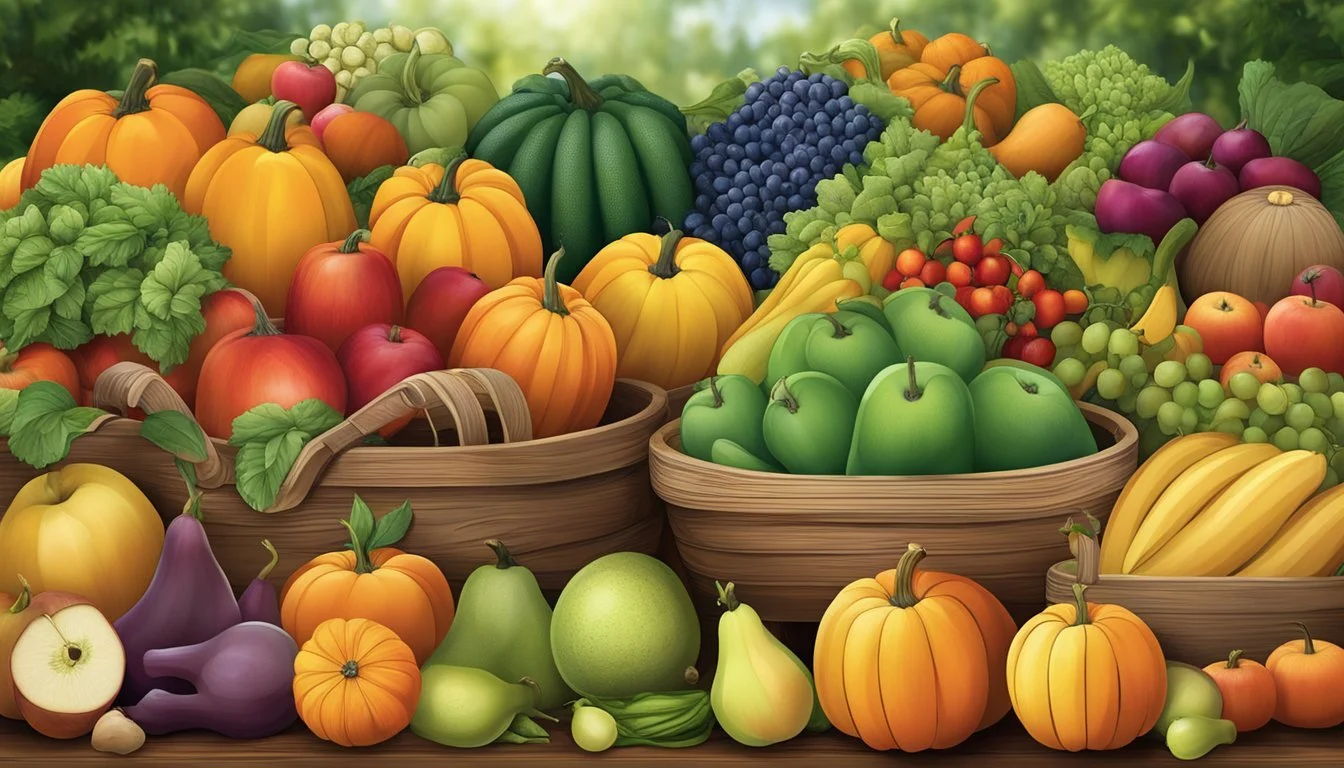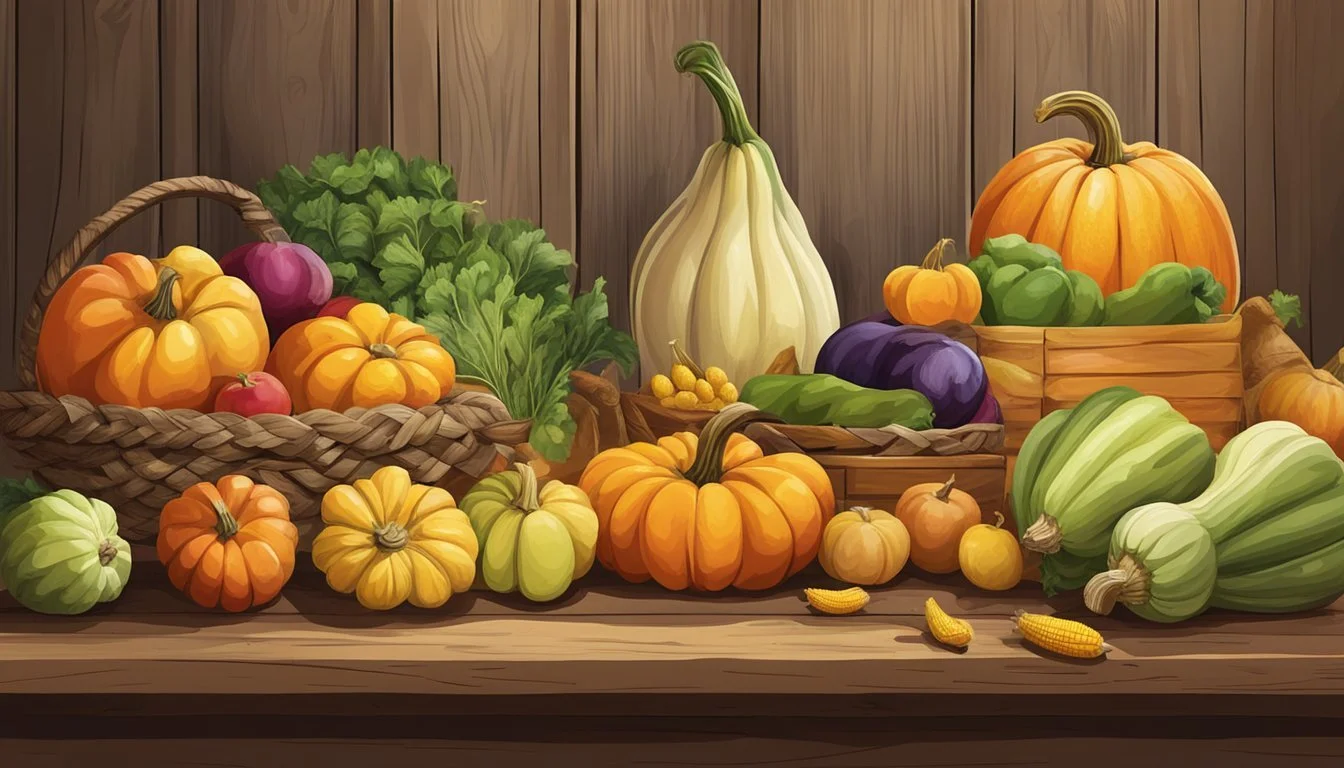Oregon Seasonal Fruit & Vegetables in October
A Harvest Guide
This Article is Part of our Oregon Seasonal Fruit & Veg Calendar
October in Oregon heralds a rich tapestry of seasonal produce that captures the essence of autumn's bounty. As the vibrancy of summer foliage transforms into an array of warm colors, local markets brim with an assortment of fruits and vegetables that offer a taste of the harvest season. With a climate conducive to a diverse range of crops, the state boasts a selection of fresh produce that spans from the sweet and tangy to the earthy and robust.
During this month, the fields and orchards of Oregon yield a variety of fruits such as pumpkins, cranberries, and late-harvest blackberries, which become sweeter and less tart as they linger on the vine. Concurrently, mushrooms, a highlight of the Pacific Northwest's foraging scene, emerge in abundance, adding a wild and flavorful twist to the conventional autumnal selection.
Vegetables, too, take center stage in the cool October climate, with staples like carrots (how long do carrots last?), cauliflower, and celery freshly available. Hearty greens such as chard and collard greens continue to flourish, providing a nutritious complement to the roots and gourds commonly found in the season's comforting dishes. Oregon's corn harvest rounds out the selection, offering a final taste of summer sweetness before the winter sets in.
Fall Harvest Overview
In October, Oregon's harvest season showcases the state's commitment to freshness and variety. The shift in weather marks a rich transition in available produce that supports local agriculture and promises robust flavors.
Significance of Seasonal Eating in Oregon
Oregonians value seasonal eating due to its support for local farming communities and its environmental sustainability. Seasonal produce requires less transportation and storage, which lessens the ecological footprint. Moreover, eating according to the seasons aligns with the natural growth cycles of the region, ensuring that consumers enjoy fruits and vegetables at their peak nutritional value and taste.
October's Bounty
Oregon's October harvest is diverse, offering everything from late summer fruits to hardy fall vegetables. Here's a snapshot of what one can expect during this bountiful month:
Fruits:
Apples
Pears
Blackberries (until mid-October)
Vegetables:
Pumpkins
Squash
Collard Greens (May through February)
Corn (August through October)
Cucumbers (July through October)
This period is the perfect time for residents and visitors alike to experience the flavors of Oregon's fall, from crisp apples to the rich, earthy tones of squash.
Seasonal Fruits
October in Oregon celebrates the harvest of a diverse range of fruits, with a special emphasis on those best enjoyed during the fall season.
Tree Fruit Varieties
Apples: October is prime time for apple picking in Oregon. Apple varieties such as Honeycrisp and Fuji offer crisp textures and sweet flavors.
Pears: Bartlett and Anjou pears are typically harvested in early fall and can be enjoyed throughout October. They are known for their juiciness and soft, buttery flesh.
Grapes: Varieties of wine and table grapes reach peak ripeness in October. They are plump and full-flavored, perfect for both eating fresh and for winemaking.
Berries and Other Soft Fruits
Cranberries: Oregon's coastal bogs produce cranberries that are harvested in October. These tart berries are commonly used in sauces, juices, and dried fruit (how long does dried fruit last?) mixes.
Berries: While the berry season is waning, some late-season varieties of blackberries can still be found in the early part of the month.
Fruits: Other fruits that might still be available in early October include late-ripening varieties of raspberries and strawberries, although their availability is more limited at this time.
Seasonal Vegetables
In Oregon, October ushers in a hearty selection of vegetables. Gardens and farms deliver a bountiful harvest that is rich in root vegetables, cruciferous favorites, and an array of squash and gourds.
Root Vegetables & Tubers
Potatoes: October marks the time for harvesting a variety of potatoes, which have been growing throughout the summer.
Beets (how long do beets last?): These deep red root vegetables are at their sweetest now.
Carrots: Crunchy and sweet, local carrots are ready for consumption.
Turnips: Often overshadowed, turnips come into season offering a peppery flavor.
Oregon's fertile soil makes it ideal for these underground treasures, elevating dishes with their fresh, earthy flavors. (What wine goes well with earthy flavors?)
Cruciferous & Leafy Greens
Broccoli: This green vegetable is known for its nutritional benefits and is widely harvested this month.
Cabbage: Stores well and often used in autumn dishes, cabbage is a staple.
Kale: Hardy and full of nutrients, kale thrives in the cooler temperatures of October.
These leafy and cruciferous vegetables not only withstand the cooling weather but also provide important nutrition during the transition to winter.
Squash & Gourds
Squash: A variety of squash, including butternut and acorn, are ready to be picked.
Pumpkins: Synonymous with fall, pumpkins are not just for carving but are a versatile vegetable in the kitchen.
These vegetables are hallmarks of fall cooking, lending themselves to both sweet and savory dishes with their rich textures and flavors.
Oregon's Unique Offerings
Oregon thrives with a diversity of crops beyond the typical fruits and vegetables. The state's rich soils and varying climates foster a collection of nuts (how long do nuts last?) and specialty crops, as well as herbs, that come into season in October, offering consumers unique local flavors and culinary possibilities.
Nuts and Specialty Crops
Hazelnuts: Oregon stands out as one of the largest producers of hazelnuts in the United States. The harvest season for hazelnuts usually begins in late September and extends through October. In this period, the nuts are at their freshest and most flavorful.
Crop Availability Hazelnuts September - October
Pumpkins: Pumpkins signify the arrival of fall and are one of Oregon's emblematic October crops. These are not just for carving Jack-o'-lanterns—their flesh is perfect for pies, soups, and other seasonal dishes.
Crop Description Pumpkins Essential for fall festivities and cuisine
Herbs and Aromatic Produce
Sage, Rosemary, Thyme: These aromatic herbs are a chef's delight and become particularly robust in the cool, damp autumn weather of Oregon. They add hearty flavors to many dishes and are a staple in fall cooking.
Herb Notable Characteristics Sage Earthy and aromatic, ideal for savory dishes Rosemary Woody and citrus-like, excellent for roasting Thyme Subtle and slightly minty, versatile in use
Oregon's greens, such as collard greens and other leafy varieties, also come into their prime in October, offering a fresh, nutritious, and flavorful addition to the state's autumn produce roster. They can complement the herbs and nuts in seasonal recipes, enriching the state's culinary landscape.
Preparation and Cooking Tips
When preparing Oregon's October produce, techniques vary from simple raw salads to complex stews. The focus should be on enhancing the natural flavors and preserving the freshness of the ingredients.
Home Cooking Techniques
Salads:
Greens: Utilize fresh chard and lettuce to create vibrant salads. For added flavor, include roasted nuts, and seasonal fruits like sliced pears.
Dressing: Prepare a homemade vinaigrette with local honey, olive oil, and a touch of apple cider vinegar to complement the salads.
Pies:
Fruits: Apples and pears from Oregon are perfect for making warm, comforting pies. For the best result, combine varieties for a balance of sweet and tart flavors.
Crust: A buttery, flaky crust is key. Consider mixing in a bit of ground almond for texture and taste.
Roasted Vegetables:
Roots: Carrots, beets, and potatoes are excellent when roasted. Coat them lightly in oil, season with herbs like rosemary, and roast until golden.
Sauce and Curry:
Tomatoes: Still available in early October, tomatoes can be cooked down into a rich sauce or incorporated into a curry with other seasonal vegetables.
Spices: Embrace warming spices like turmeric and cumin to enhance the depth of flavor, especially in curries and stews.
Preserving the Harvest
Stews:
Technique: For stews, slow cook a medley of October vegetables like carrots, potatoes, and pumpkin to extract maximum flavor.
Storage: These stewed dishes (What wine goes well with stewed dishes?) freeze incredibly well, making them an easy go-to meal throughout the coming cold months.
Preserves:
Jam: Make jam from the tail end of the blackberry season.
Ingredients: Blackberries, sugar, lemon juice.
Method: Cook berries and sugar; add lemon juice; simmer until thickened.
Pickling: Extend the life of vegetables including beets and carrots.
Brine: Water, vinegar, salt, sugar, and spices such as dill or mustard seeds.
Process: Clean and cut vegetables, prepare brine, mix and seal in sterilized jars.
By selecting the appropriate techniques for Oregon's seasonal bounty, one can fully enjoy the flavors of October, whether in the immediacy of a fresh salad or the preserved satisfaction of a homemade jam.
Health Benefits and Nutrition
In October, fruits and vegetables like apples, squash, greens, sweet potatoes, and beets are not only abundant in Oregon but also packed with essential nutrients that contribute significantly to a healthy diet.
The Nutritional Value of Seasonal Produce
Apples: Rich in fiber, vitamin C, and various antioxidants, apples are known for their role in reducing the risk of chronic diseases.
Squash: Offering a variety of types, including butternut squash (how long does butternut squash last?), this vegetable is a great source of vitamins A and C, magnesium, and potassium.
Greens: Leafy greens such as kale and chard provide high levels of vitamins A, C, and K, as well as calcium and iron, beneficial for bone health and blood clotting.
Sweet Potatoes: High in beta-carotene, which the body converts into vitamin A, sweet potatoes support good vision, immune health, and skin integrity.
Beets: Known for their earthy flavor and vibrant color, beets are high in fiber, folate, and manganese, and they support heart health and inflammation control.
Dietary Significance of Fresh Produce
Consuming fresh produce in their peak season means the fruits and vegetables are more nutrient-dense, as they are harvested at the optimal time for flavor and nutritional content.
Apples and sweet potatoes are excellent for providing long-lasting energy due to their complex carbohydrates and fiber.
Squash and beets offer dietary fiber that aids in digestion and helps maintain steady blood sugar levels.
Greens are essential for a balanced diet due to their low calorie count and high nutrient density, ideal for weight management and overall health.
Farming and Sustainability
In Oregon, the integration of sustainable practices in farming and the adherence to seasonal cycles are paramount to the agricultural sector. Farmers prioritize the health of their land and the quality of their produce, ensuring a reliable harvest year after year.
Local Farming Practices
Oregon farmers are known for their commitment to sustainability, particularly in October when the harvest is in full swing. Local farming practices include crop rotation, the use of cover crops, and reduced tillage to maintain soil health. Farmers may also employ integrated pest management techniques to minimize chemical use. These practices ensure that crops such as pumpkins, apples, and pears are produced with respect for the natural environment.
Crop Rotation: To prevent soil depletion and break pest cycles.
Cover Crops: Like clover or rye, used to suppress weeds and enhance soil fertility.
Reduced Tillage: This method helps to preserve soil structure and reduce erosion.
Sustainable Agriculture and Seasonality
Sustainable agriculture in Oregon is intrinsically linked with seasonality. Farmers plan their crop schedules to align with the natural growing seasons, which conserves resources and supports local ecosystems. In October, the emphasis is on harvesting late-season crops that thrive in the region's climate, such as:
Vegetables: leafy greens, root vegetables, and squashes.
Fruits: Various apples and pears, along with late berries.
By focusing on seasonally appropriate crops, farmers minimize the need for artificial heating and cooling, reducing energy consumption and carbon footprint. Sustainable agriculture ensures the longevity of Oregon's farming industry and the health of its consumers.









